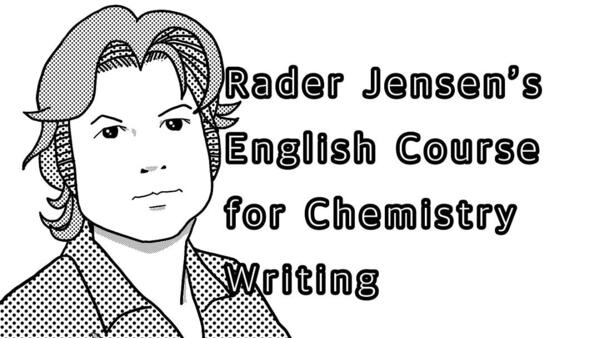CSJ Journals
[化学論文のための英語講座] 第45回:形容詞 Part1
(English version is here.)
形容詞 Part1 位置
形容詞は名詞の姿、性質、または特徴を述べます。形容詞は幾つかの種類に分類できます。比較「more, less」最上級「highest, lowest」所有「our, their」名前「Japanese, Darwinian」記述「ambient, cold」疑問「what, which」分配「each, every」複合「nickel-catalysed」述語「is known」分詞「each, every」と限定「some, that」などあります。
今回は形容詞の位置についてみていきましょう。形容詞は名詞の前からも後ろからも修飾できますが、位置によって意味が少し異なります。前に置くと、名詞を直接修飾します。例文を見てみましょう。
1. In a previous report, similar results were presented.
訳文:以前の報告では、同様の結果が提示された。
2. A similar procedure was used in this work.
訳文:この作業でも同様の手順が使用された。
3. The desired product was obtained as a white, crystalline solid.
訳文:目的の生成物が白色の結晶性固体として得られた。
以上の例文では形容詞が名詞を限定します。(限定用法)
形容詞を名詞の後に置く場合、存在動詞「be」または感覚動詞「seems, looks, sounds」を形容詞の前に置きます。例文を見てみましょう。
4. The spectra were informative.
訳文:スペクトルは有益だった。
解説:「were」は存在動詞です。
5. This procedure seems promising.
訳文:この手順は有望に思えます。
解説:「seems」は感覚動詞です。
以上の例文では形容詞が名詞の性質や特徴を述べます。例文4ではスペクトルの特徴の一つは有益さです。例文5では手順の特徴の一つは有望に思えることです。これは叙述用法と言われます。両方の用法を使った例文を見てみましょう。
6. The results of the X-ray crystallography were unambiguous.
訳文:X線結晶構造解析の結果は明白だった。
解説:「were」は存在動詞です。
7. The proposed synthetic strategy in this work is efficient and versatile.
訳文:この研究で提案された合成戦略は、効率的で汎用性が高い。
解説:「is」は存在動詞です。
例文6では結果が結晶構造解析の中のX線に限られ(限定用法)、その結果は明白です(叙述用法)。例文7では戦略は提案された合成に限られ(限定用法)、その戦略の特徴は効率的で汎用性が高いことです(叙述用法)。
限定用法と叙述用法の違いを簡単に日本語で示します。
difficult reaction:難しい反応(どんな状況でも難しい)
reaction is difficult:反応は難しい(今は、この環境では、難しい)
[補足] 例文1〜7では「this, the, a」などがイタリック体になっていたことに気づいたでしょうか。これらも限定形容詞の役割を果たします。限定形容詞(制限形容詞)は所有形容詞「our, their」や分配形容詞「each, every」など、他の幾つかの種類と重複します。
次回は「形容詞 Part2」です。
Adjectives describe the appearance, quality, or characteristics of nouns. Adjectives can be classified into several types: Comparative (more, less), superlative (highest, lowest), possessive (our, their), nominative (Japanese, Darwinian), descriptive (ambient, cold), interrogative (what, which), distributive (each, every), compound (nickel-catalysed), predicate (is known), participle (each, every), and definite (some, that).
This time, let us look at adjective position. Adjectives can modify a noun either before or after, but the meaning can change somewhat depending on the position. When placed in front, the noun is directly modified. Let us look at some examples.
1. In a previous report, similar results were presented.
2. A similar procedure was used in this work.
3. The desired product was obtained as a white, crystalline solid.
In the above examples, the adjective limits the noun. (limiting)
When locating an adjective after a noun, a verb of existence (be) or a sensory verb (seems, looks, sounds) is placed before the adjective. Let us look at some examples.
4. The spectra were informative.
Explanation: were is a verb of existence.
5. This procedure seems promising.
Explanation: seems is a sensory verb.
In the above examples, the adjective describes the quality or characteristic of a noun. In example 4, one characteristic of the spectra is being informative. In example 5, one characteristic of the procedure is seeming promising. This is called predicative usage. Let us look at examples using both forms.
6. The results of the X-ray crystallography were unambiguous.
7. The proposed synthetic strategy in this work is efficient and versatile.
In example 6, the results are limited to the X-ray crystal structure analysis (limiting), and those results are unambiguous (predicative). In example 7, the strategy is limited to the suggested synthesis (limiting), and characteristics of that strategy are efficiency and versatility (predicative).
The difference between limiting and predicative can be shown by the following:
Difficult reaction: the reaction is difficult under all circumstances
Reaction is difficult: the reaction is difficult now in the present environment
Supplement: In examples 1 through 7, you may have noticed that (this, the, a) and the like are shown in italics. This are also limiting. Limiting adjectives (restricting adjectives) overlap with several other types, such as possessive (our, their) and distributive adjectives (each, every).
At next time, we will discuss Adjectives 2.
